article In conversation with
Sam Hodge
In conversation with
Sam Hodge
Sam Hodge

In conversation with Sam Hodge
about place, storytelling and
collaborating with matter.
about place, storytelling and
collaborating with matter.
In conversation with Sam Hodge
about place, storytelling and
collaborating with matter.
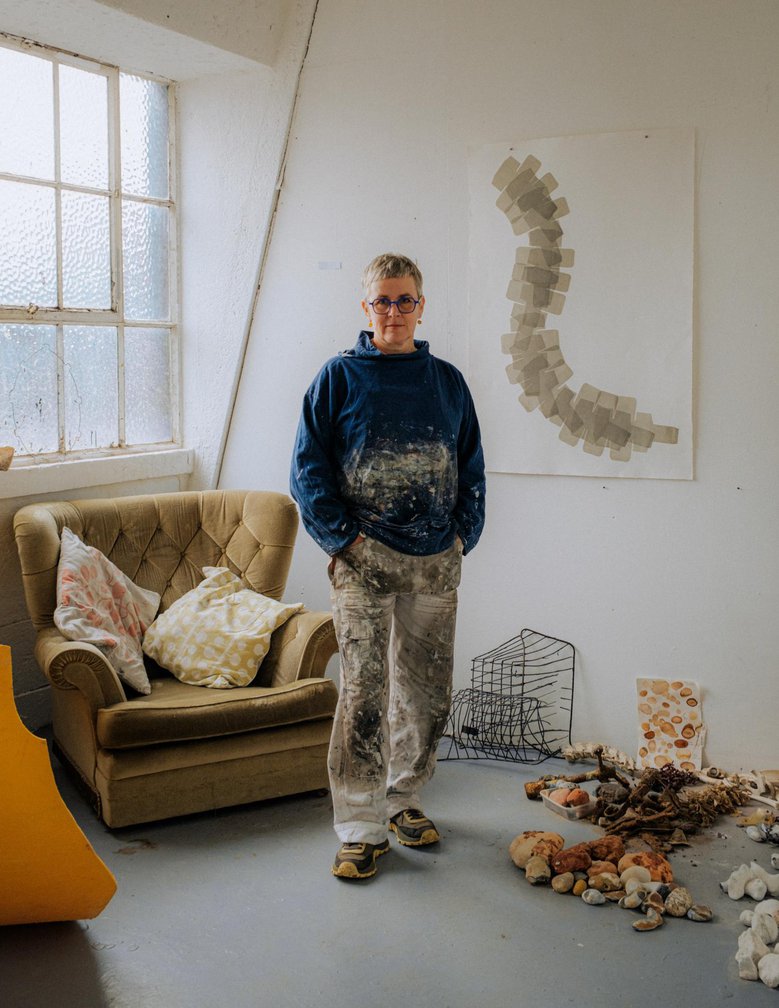
Influenced by landscape, material and the natural sciences, Sam Hodge is a print and paint artist exploring the dynamic and generative properties of matter. Inspired by the biological processes of growth and decay, her works are heavily inspired by her experiences as a conservator.
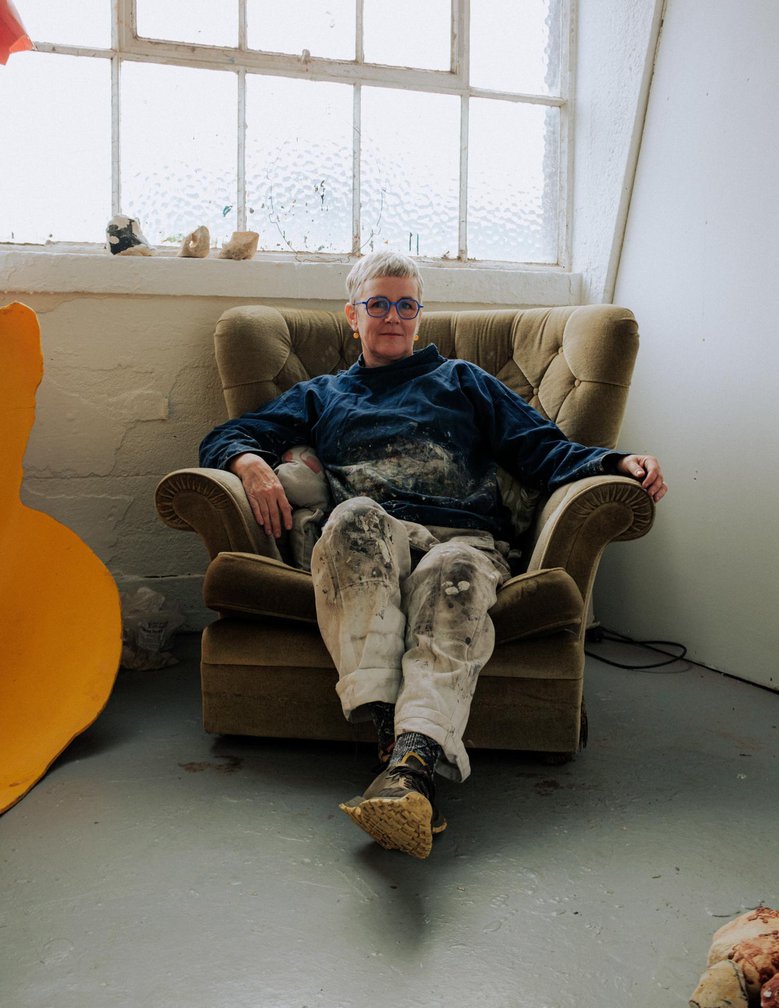
Artiq When did you first decide that you wanted to be an artist? What inspired this decision?
Sam I realised I wanted to be an artist around the age of 14, but at school and home I was strongly encouraged to pursue more academic subjects that would get me a ‘good job’. I kept up with drawing, painting and printmaking in my free time, but it wasn’t until I was in my 40’s with two small children and a part-time job as a painting conservator, that I thought ‘If I don’t do it now, I never will’ and I finally got a studio and started to take my own making more seriously. I am not sure what inspired my decision to be an artist, it really is more of a compulsion than a decision, something I just have to do. It gives me a huge amount of satisfaction, (as well as frustration!). The satisfaction comes from the permission it gives me to look intensely at things that catch my attention and think about what they mean to me while grappling with physical stuff until something that I like miraculously emerges.
Artiq You previously studied Natural Sciences at Cambridge University, and then Conservation of Easel Paintings at The Courtauld. How does this background inform the choices that you make within your practice?
Sam My background in Natural Science and Conservation has definitely informed the way I make my own work, which is very much concerned with materials, what they do and how they transform over time. Matter has its own power to create and I try to make work in collaboration with it. I am interested in where my materials come from, and how they behave, both in the studio and in the longer term (for example, some of my work has been consciously made with pigments that will change or lose their colour, such as glow in the dark or fugitive pigments). Having studied Painting Conservation also helps me to make my own materials and paints as I know something about traditional ways of sourcing and making painting materials and about their chemistry.
I think that I originally studied Natural Sciences, partly because I loved the visual part of it. I love looking down microscopes and inside things and I love scientific illustrations and collections. I think that this has made its way into my work.
Sam I realised I wanted to be an artist around the age of 14, but at school and home I was strongly encouraged to pursue more academic subjects that would get me a ‘good job’. I kept up with drawing, painting and printmaking in my free time, but it wasn’t until I was in my 40’s with two small children and a part-time job as a painting conservator, that I thought ‘If I don’t do it now, I never will’ and I finally got a studio and started to take my own making more seriously. I am not sure what inspired my decision to be an artist, it really is more of a compulsion than a decision, something I just have to do. It gives me a huge amount of satisfaction, (as well as frustration!). The satisfaction comes from the permission it gives me to look intensely at things that catch my attention and think about what they mean to me while grappling with physical stuff until something that I like miraculously emerges.
Artiq You previously studied Natural Sciences at Cambridge University, and then Conservation of Easel Paintings at The Courtauld. How does this background inform the choices that you make within your practice?
Sam My background in Natural Science and Conservation has definitely informed the way I make my own work, which is very much concerned with materials, what they do and how they transform over time. Matter has its own power to create and I try to make work in collaboration with it. I am interested in where my materials come from, and how they behave, both in the studio and in the longer term (for example, some of my work has been consciously made with pigments that will change or lose their colour, such as glow in the dark or fugitive pigments). Having studied Painting Conservation also helps me to make my own materials and paints as I know something about traditional ways of sourcing and making painting materials and about their chemistry.
I think that I originally studied Natural Sciences, partly because I loved the visual part of it. I love looking down microscopes and inside things and I love scientific illustrations and collections. I think that this has made its way into my work.
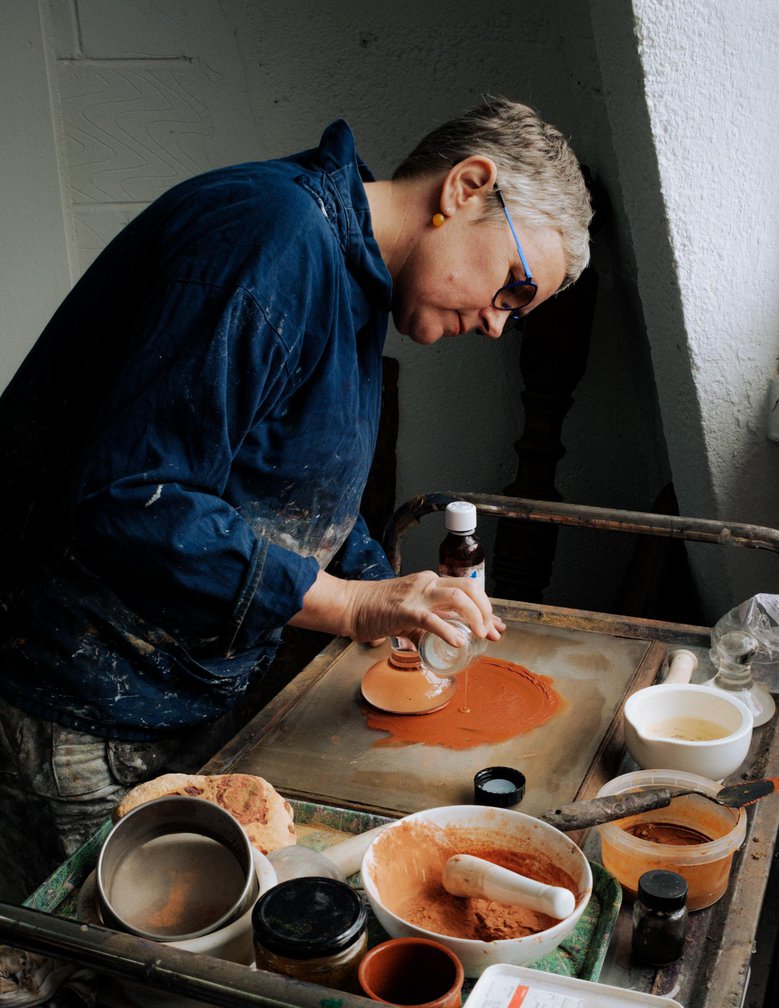
Artiq You frequently collect materials to make your own pigments. Can you describe the process of sourcing these materials, and the techniques you use to make them into pigment?
Sam I started making my own pigments and inks from found things in 2019 while on a residency in the Greek Island of Symi, inspired by Jason Logan’s work. Since then, I look at everything as a potential source of colour. This can be natural earths and plants, but also things discarded by humans such as copper wiring, rusty metal and bricks. During lockdown I found materials to make work in my own kitchen waste bin, garden and local parks. I also collected stuff dumped by humans into the Thames and washed up on its shoreline – particularly coal. At the moment, I am collecting coloured earths from coastal cliffs during my walks along the coast path of England and Wales. Whenever I go for a walk, I take small bags and takeaway containers and a pen knife to collect material.
Different materials require different techniques to transform them into pigments and inks.
Coal, rocks, earths and bricks have to be crushed with a hammer and then ground to dust with a pestle and mortar. I then sieve the dust through a fine ceramic sieve and mix it with whatever binding medium I am using (usually linseed oil or gum arabic) with a muller on an etched glass plate. I put the mixed paint into tubes or pans to store it. I make my own charcoal from twigs, bones and seaweed by putting them inside a metal container in a barbeque or someone’s woodburner. This can then be made into paint in the same way as the earths. I also make inks from leaves, bark and acorns by boiling them in water, adding gum arabic to thicken if necessary. I often combine plant inks with extracts from metal objects I have found, making bright turquoise verdigris by exposing scraps of copper piping or wiring to vinegar fumes or making rust tinted water by leaving rusty metal objects in water and vinegar.
Sam I started making my own pigments and inks from found things in 2019 while on a residency in the Greek Island of Symi, inspired by Jason Logan’s work. Since then, I look at everything as a potential source of colour. This can be natural earths and plants, but also things discarded by humans such as copper wiring, rusty metal and bricks. During lockdown I found materials to make work in my own kitchen waste bin, garden and local parks. I also collected stuff dumped by humans into the Thames and washed up on its shoreline – particularly coal. At the moment, I am collecting coloured earths from coastal cliffs during my walks along the coast path of England and Wales. Whenever I go for a walk, I take small bags and takeaway containers and a pen knife to collect material.
Different materials require different techniques to transform them into pigments and inks.
Coal, rocks, earths and bricks have to be crushed with a hammer and then ground to dust with a pestle and mortar. I then sieve the dust through a fine ceramic sieve and mix it with whatever binding medium I am using (usually linseed oil or gum arabic) with a muller on an etched glass plate. I put the mixed paint into tubes or pans to store it. I make my own charcoal from twigs, bones and seaweed by putting them inside a metal container in a barbeque or someone’s woodburner. This can then be made into paint in the same way as the earths. I also make inks from leaves, bark and acorns by boiling them in water, adding gum arabic to thicken if necessary. I often combine plant inks with extracts from metal objects I have found, making bright turquoise verdigris by exposing scraps of copper piping or wiring to vinegar fumes or making rust tinted water by leaving rusty metal objects in water and vinegar.
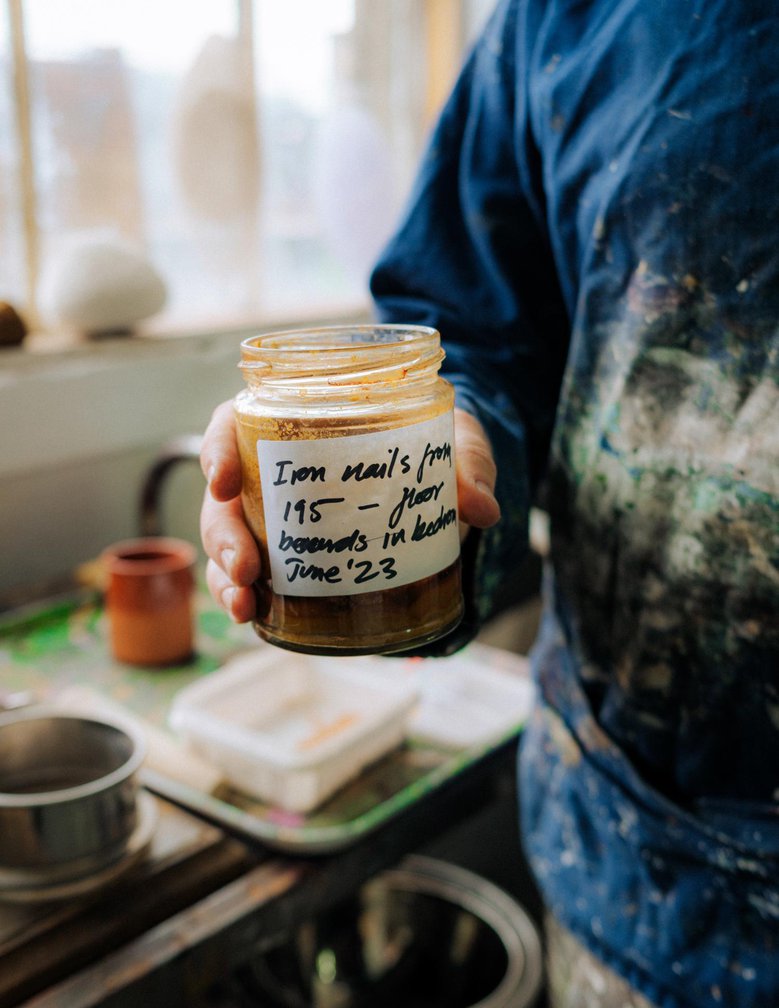
Artiq You work with both painting and printmaking through your practice. Can you discuss the similarities and differences between these ways of working? Is there any particular method which you are most drawn to?
Sam I switch backwards and forwards between print and painting and they feed off each other. I like the range of material processes involved in printmaking and the lack of complete control I have as texture and form are transferred to paper. Before I had a studio a lot of my work and experimentation was done in the print studio and I still find myself thinking of new projects through printing techniques and processes. Print has proved to be the best way for me to re-present the discarded and damaged human objects that I find and collect (for unfolded cardboard boxes from my recycling bin, scraps of beach plastic, broken mobile screens, and rubber bands discarded by postmen). I press these objects directly into etching plates or onto paper or trace their forms onto etching plates with drawing or photographic processes. These prints draw attention to the ambiguous and often animate seeming nature of the objects, transformed so that their original function is no longer apparent.
But I also love paint and the freedom and larger scale it can give. Making monotypes seems like a halfway house between the two and some of my recent work has also involved mixing monotypes with watercolour by collaging them together. After several years making work mainly on paper I have plans to return to painting on canvas, panel found supports in 2024 and to make some larger scale work.
Sam I switch backwards and forwards between print and painting and they feed off each other. I like the range of material processes involved in printmaking and the lack of complete control I have as texture and form are transferred to paper. Before I had a studio a lot of my work and experimentation was done in the print studio and I still find myself thinking of new projects through printing techniques and processes. Print has proved to be the best way for me to re-present the discarded and damaged human objects that I find and collect (for unfolded cardboard boxes from my recycling bin, scraps of beach plastic, broken mobile screens, and rubber bands discarded by postmen). I press these objects directly into etching plates or onto paper or trace their forms onto etching plates with drawing or photographic processes. These prints draw attention to the ambiguous and often animate seeming nature of the objects, transformed so that their original function is no longer apparent.
But I also love paint and the freedom and larger scale it can give. Making monotypes seems like a halfway house between the two and some of my recent work has also involved mixing monotypes with watercolour by collaging them together. After several years making work mainly on paper I have plans to return to painting on canvas, panel found supports in 2024 and to make some larger scale work.
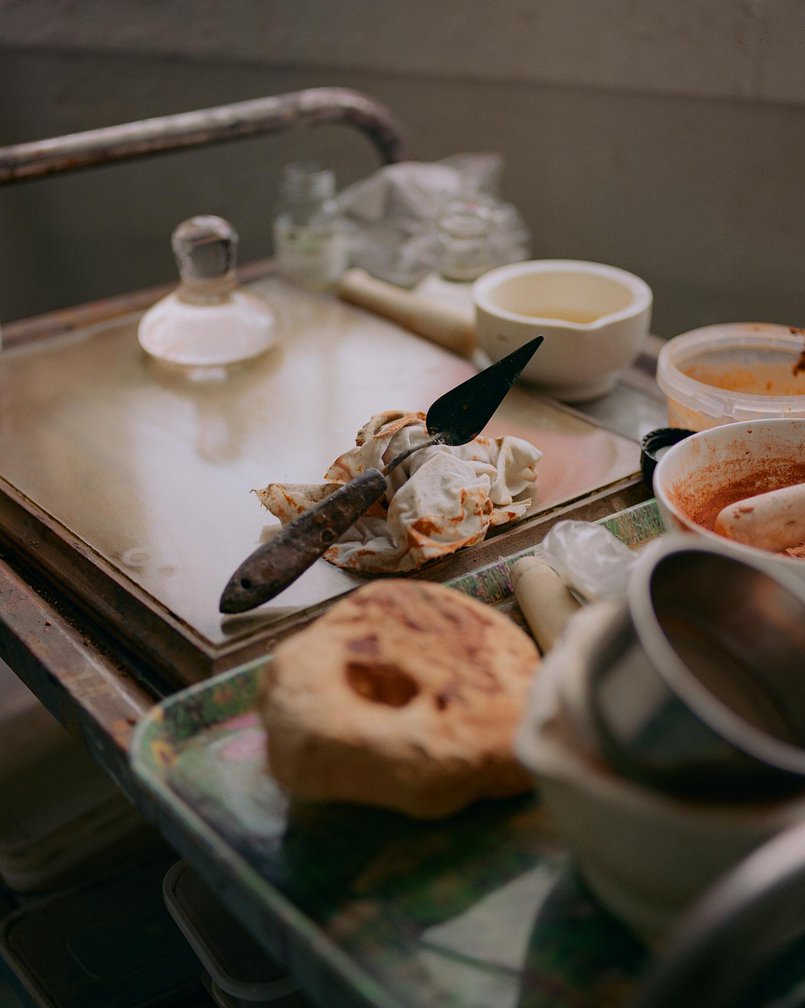
Artiq The formations within your work are often unpredictable, created through the expanding, drying and settling of pigments, as within your ‘Colour out of Place’ series. Can you further discuss this way of making? How much do you control the outcome, and how much is left to the materials themselves?
Sam I like to encourage paints and inks to make their own mark. My recent ‘Colour out of Place’ series is a good example of this. To make these I have been working with paints and inks from found materials on paper. I first pour water on to the paper flat on the ground and then drip ink or paint bound with gum arabic into it, swish it around by agitating the paper and then leave it to dry for several days. The paper swells and buckles in response to moisture and the paint flows into the dips. As the water evaporates, some of the pigment is drawn up into tidelines by capillary action, while the heavier parts sink and settle on the paper. In some of these works I encourage chemical reactions to happen on the paper, for example when plants inks meet and flow into rust ink, the iron reacts with plant tannins to turn both colours black. In some of these works I add branching patterns that emerge when paint in squashed and pulled apart, collaged or printed on top of the watercolour.
I bring the different materials together, but the patterns, shapes and colours emerge from physical processes in the paint. They are always different and impossible to control completely. Making with found materials (including water gathered from rivers, canals and sea) increases the unpredictable nature of these processes. The pigments and inks are not pure and they separate into different colours on the paper or react with each other, oxidise in the air or form crystals. Some will continue to change in the future, while others will be very stable. My role is to find the patterns that I like and select and combine the ones that say something to me. I crop and flatten the paper to draw attention to the forms that have emerged, which echo those found in geological and biological systems.
Sam I like to encourage paints and inks to make their own mark. My recent ‘Colour out of Place’ series is a good example of this. To make these I have been working with paints and inks from found materials on paper. I first pour water on to the paper flat on the ground and then drip ink or paint bound with gum arabic into it, swish it around by agitating the paper and then leave it to dry for several days. The paper swells and buckles in response to moisture and the paint flows into the dips. As the water evaporates, some of the pigment is drawn up into tidelines by capillary action, while the heavier parts sink and settle on the paper. In some of these works I encourage chemical reactions to happen on the paper, for example when plants inks meet and flow into rust ink, the iron reacts with plant tannins to turn both colours black. In some of these works I add branching patterns that emerge when paint in squashed and pulled apart, collaged or printed on top of the watercolour.
I bring the different materials together, but the patterns, shapes and colours emerge from physical processes in the paint. They are always different and impossible to control completely. Making with found materials (including water gathered from rivers, canals and sea) increases the unpredictable nature of these processes. The pigments and inks are not pure and they separate into different colours on the paper or react with each other, oxidise in the air or form crystals. Some will continue to change in the future, while others will be very stable. My role is to find the patterns that I like and select and combine the ones that say something to me. I crop and flatten the paper to draw attention to the forms that have emerged, which echo those found in geological and biological systems.
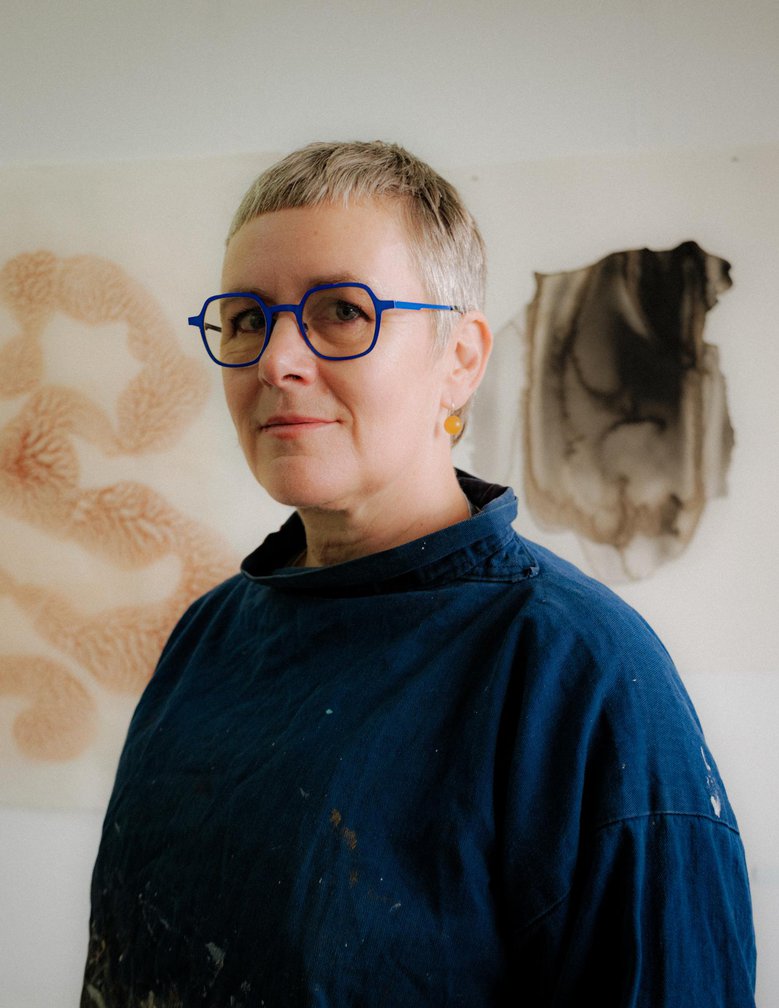
Artiq Earlier this year you had an exhibition ‘Every Contact Leaves a Trace’ at 195 Mare Street, making pigments from bricks and soot you found at the house. How much does site inform your practice? Are there any particular sites you would like to work with next?
Sam One of the joys of making work with found materials is the connection that it makes with particular places. When I pick up things and spend time with them to transform them into paint, I start to think about what they are made of how they got to be where they are. 195 Mare Street is a late 17th century house in Hackney and as I was making pigment from some of the soft and brightly coloured original bricks I found buried in the garden, I started to think about how and where these bricks were made. Where did the clay come from? what fired the kilns? who made, carried and built with them? What happened within the walls they built? Similarly, the soot from the fireplaces carries its smell and its history of interaction with humans into my studio and onto the paper. Sometimes this influences the forms the work takes, so for example the large dendritic monotypes I made with brick dust for ‘Every Contact Leaves a Trace’ have twisting, symmetrical forms which have elements of both Baroque decoration and female anatomy (connecting with the history of the house as an Elizabeth Fry refuge for women and its current owner who is writing a history of childbirth). These material connections to particular places, their history, ecology, and geology, are very important to me and I hope they are also communicated to the viewers of my work.
In 2024 I am planning to make more prints and paintings with earths from eroding cliffs on the coast of England and Wales and with materials from the Thames shore. I want to make work from and about the shifting edges of the country, which are changing more and more quickly as climate induced sea level rises increase the rate of coastal erosion.
Artiq Do you have any exciting projects or shows coming up that you would like to share with us?
Sam 2023 has been a very busy year for me with a big solo exhibition and several group shows and I am looking forward to spending more time in my studio in 2024, experimenting and developing some new ways of working.
I have a couple of exhibitions coming up; a group show ‘Momentum’ at Fitzrovia Gallery at the end of January and an exhibition with at the Holt Festival in Norfolk in July. I will be continuing to collaborate with a group of artists concerned with ecological themes gathered together by Groundwork Gallery in King’s Lynn. We are planning an event/performance on the North Norfolk Coast on Earth Day in April and an exhibition and workshops in Bideford, Dorset in May. I am also beginning to make plans with some other artists to organise a group show about eroding coastlines.
Sam One of the joys of making work with found materials is the connection that it makes with particular places. When I pick up things and spend time with them to transform them into paint, I start to think about what they are made of how they got to be where they are. 195 Mare Street is a late 17th century house in Hackney and as I was making pigment from some of the soft and brightly coloured original bricks I found buried in the garden, I started to think about how and where these bricks were made. Where did the clay come from? what fired the kilns? who made, carried and built with them? What happened within the walls they built? Similarly, the soot from the fireplaces carries its smell and its history of interaction with humans into my studio and onto the paper. Sometimes this influences the forms the work takes, so for example the large dendritic monotypes I made with brick dust for ‘Every Contact Leaves a Trace’ have twisting, symmetrical forms which have elements of both Baroque decoration and female anatomy (connecting with the history of the house as an Elizabeth Fry refuge for women and its current owner who is writing a history of childbirth). These material connections to particular places, their history, ecology, and geology, are very important to me and I hope they are also communicated to the viewers of my work.
In 2024 I am planning to make more prints and paintings with earths from eroding cliffs on the coast of England and Wales and with materials from the Thames shore. I want to make work from and about the shifting edges of the country, which are changing more and more quickly as climate induced sea level rises increase the rate of coastal erosion.
Artiq Do you have any exciting projects or shows coming up that you would like to share with us?
Sam 2023 has been a very busy year for me with a big solo exhibition and several group shows and I am looking forward to spending more time in my studio in 2024, experimenting and developing some new ways of working.
I have a couple of exhibitions coming up; a group show ‘Momentum’ at Fitzrovia Gallery at the end of January and an exhibition with at the Holt Festival in Norfolk in July. I will be continuing to collaborate with a group of artists concerned with ecological themes gathered together by Groundwork Gallery in King’s Lynn. We are planning an event/performance on the North Norfolk Coast on Earth Day in April and an exhibition and workshops in Bideford, Dorset in May. I am also beginning to make plans with some other artists to organise a group show about eroding coastlines.